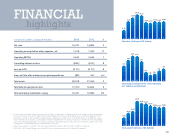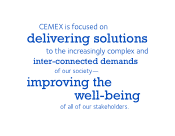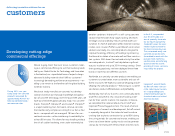Cemex 2013 Annual Report Download - page 19
Download and view the complete annual report
Please find page 19 of the 2013 Cemex annual report below. You can navigate through the pages in the report by either clicking on the pages listed below, or by using the keyword search tool below to find specific information within the annual report.
Moreover, we are continuously evaluating investment
opportunities in the development of new energy proj-
ects. In Mexico, we are in the process of developing
a series of energy projects, beginning with the con-
struction of the Ventika wind-powered energy park
in the northern state of Nuevo Leon. With a minority
equity stake not exceeding 5%, our primary role will be
to provide technical expertise for the development of
these projects.
To further minimize the ecological impact of our oper-
ations, we continue our efforts to replace clinker with
alternative cementitious materials—many of which are
derived from the waste of other industries. Materials
that we are using instead of clinker include fly ash from
power plants, blast furnace slag from pig iron produc-
tion, and volcanic ash. In 2013, our overall clinker factor
(the ratio of clinker content to total cement production)
was reduced by approximately 8% when compared to
our baseline year of 1990.
In 2013, we successfully obtained the United Nations Framework Convention on
Climate Change (UNFCCC) accreditation for six new initiatives as Clean Development
Mechanisms (CDM), including projects in Mexico and Panama. Overall, our full CDM
portfolio now includes 19 officially registered projects for a total carbon offset po-
tential of 2.44 million tons of CO2 emissions per year. In addition, CEMEX registered a
carbon reduction project in Miami, Florida, under the Verified Carbon Standard (VCS),
the world’s leading voluntary greenhouse gas program. Together with our project in
Louisville, Kentucky, which we registered in 2012, these projects represent an annual
reduction potential of more than 360,000 tons of CO2. Our full portfolio has the po-
tential to mitigate a total of approximately 2.8 million tons of CO2 per year.
UNFCCC accreditation for new initiatives
Responsibly managing
biodiversity and water
Beyond reducing our carbon footprint, we work diligently
to responsibly manage the habitat within and around our
operations to protect biodiversity and maximize our con-
tribution to nature conservation. To this end, we continue
working to develop quarry rehabilitation plans for all of
our active cement and aggregates sites.
Moreover, our biodiversity management recently earned
accolades from the European Aggregates Association.
Specifically, our Soto Pajares Quarry in Spain won the
Special Award for Biodiversity at the 2013 Sustainable
Development Awards for its outstanding protection,
enhancement, and creation of key habitats for important
species. Also, our Rugeley Quarry in the United Kingdom
received the Recognition of Achievement for its signifi-
cant restoration work and excellent habitat management
Net specific CO2
emissions reduction
(from our 1990 baseline)
-24%
1990 2013
Indeed, as compared with our 1990 baseline, at the end
of 2013, we had achieved a reduction of approximately
24% in our specific net CO2 emissions per ton of cement
produced. Consequently, for the year, we avoided ap-
proximately 7 million metric tons of CO2 emissions—in-
cluding emissions avoided through the EURUS wind farm
in Mexico. This is equal to the emissions generated by
1.35 million passenger vehicles per year.
Soto Pajares Quarry, Spain
[18]
























